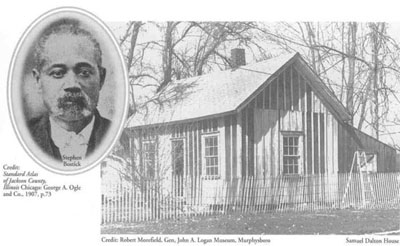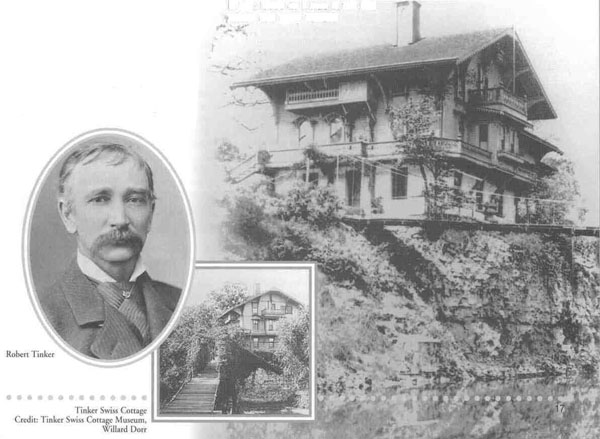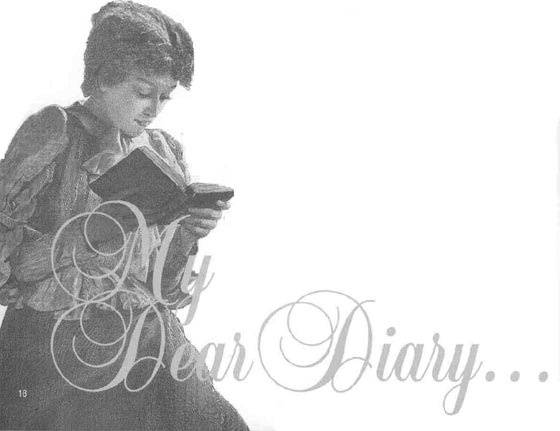 |
Home | Search | Browse | About IPO | Staff | Links |
 |
Home | Search | Browse | About IPO | Staff | Links |
|

Family history provides a holistic and nontraditional approach to investigating and understanding the past. Your local history museum, especially if it is an historic house, can be a magnificent resource for teaching about Illinois history. These museums offer both three-dimensional and archival materials that illustrate your community's past. A museum's collection in partnership with family history can connect the textbook your students may perceive as boring to their daily life. It is hoped that this article and accompanying lessons will do two things: first, inspire your own ideas and provide tools to use family history to teach local, national, and international history topics; and second, illustrate how you can use your local historic house museum as a resource for your lessons.
Some thoughts on family history launch our investigation. Each family has its own story because its members are distinctive. Family history is not the same as genealogy. A person's genealogy can be recorded without telling stories. Genealogy, like a pedigree, focuses on bloodlines by establishing birth and death dates and familial relationships. A family's story or history can be recorded without having a complete genealogy. Family history attempts to explain the family's relationship to society and provides a geographic rationale for its location. We create history through our daily tasks. A community's history is the sum of its families' lifestyles and economic situations, as well as their actions, reactions, and interactions with their own members and other families inside and outside the community. Great historical events and social movements did not happen spontaneously. Family members or individuals made them happen. Victory Gardens of the Second World War did not plant themselves, families planted them. Protests during the Vietnam War were not the work of an unknown mob but instead were organized and conducted by individuals from various families. Society was divided on the war for the same reasons that families were divided. Family history is as controversial as any other historical perspective because families create history. Family history is not always pretty, happy, and romantic. Some of our forefathers embellished the truth to keep themselves out of trouble, prevent present or future embarrassment, play a bigger or smaller role in the event, or perhaps just to have a story to tell. Caution must be exercised, and other research must be conducted to verify the stories. Yet these oral family histories provide a wonderfully interpretive source. Oral history provides one person's perspective on the event, and like witnesses to an accident, the more of those histories that are collected, 14 the better our understanding of the whole picture. This form of history offers the advantage of investigating the past with the people who lived it. An elder's reminiscences are a powerful way to experience the past. Ray Bradbury's short story, "The Time Machine," illustrates both the power and the problems with this form of family history. "Time Machine" opens with a boy inviting his friends for a trip in his time machine. Then he takes them to visit an old man who remembers the Civil War but has forgotten on which side he fought. As the boy prompts him with questions, the man describes battles and feelings, but cannot remember his uniform's color. His stories are interrupted by his frequent naps, and when he realizes the boys call him a time machine, he invites them to come for trips anytime they wish. Finding a time machine can be the start or end point of historical research based on a family story. Next, consider historical house museums. They tend to reflect famous and wealthy families and/or architecturally significant houses. Well-known museums of this type include Frank Lloyd Wright's Dana-Thomas House and the Lincoln Home, both in Springfield, and the Ronald Reagan Boyhood Home in Dixon. Abraham Lincoln and Ronald Reagan were both presidents, and you can probably think of ways to incorporate a tour or slide presentation of their homes into lessons on everything from civil unrest to international relations. A home built or remodeled by a famous architect can easily be used to illustrate trends in decorative arts or other themes of time period encompassing the construction of the house. Homes of lesser-known but wealthy northern Illinois families include the David Davis Mansion in Bloomington and the Ellwood House in DeKalb. Both focus on the role of women and servants in upper-middle class households. They also illustrate social, agricultural, and political history topics. Those house museums tell how one man or one family, such as Ellwood's barbed-wire business, affected society. Not all historic house museums were the homes of rich, white families. Historic homes should reflect different classes, races, and ethnic groups. A classic example is in Murphysboro where Samuel Dalton, a former slave and Civil War veteran built his two-room batten-board home in 1887. By 1897 he had added a 10-foot-by-10-foot shed-roof addition to serve as a kitchen. Typical African-American life of the 1890s is included in the building's interpretation. Houses offer a glimpse at American life. They illustrate an individual family member's involvement in local events, national politics, and international trade. But most important to this discussion, they can illustrate how particular families coped with and participated in community life, religion, births, marriages, education, illness, separation from
15

loved ones, and finally, death. Those issues are common to the human experience regardless of cultural group or time period. Museum staff interpret events through traditional period rooms and encased exhibits using the personal writings and worldly goods of the family members involved. Unlike other history museums, artifacts or objects in a historic house's period rooms are viewed in what can be referred to as a natural habitat. Pots and pans are in the kitchen. Chairs, rugs, family portraits, and perhaps games are in the parlor, sitting room, or living room. Beds, quilts, washstands, and hairbrushes are in bedrooms. The arrangement of artifacts in a room may be guided by a historic photograph of that room, by oral histories recorded by family members or family friends, or by general research of a particular time period and economic class that may also include family writings. Good research uses all available sources. Tinker Swiss Cottage Museum, Rockford, stands apart from the other houses mentioned in that the Tinker family was of the middle class and is not famous for any special thing. Robert Tinker (1836-1924) was not a military hero, author, statesman, or inventor. Nor was the house built by a well-known architect. In fact, Robert Tinker designed it and did most of the finishing work himself. Like the Tinker family home, there is probably a historic house museum near you whose family was only well-known locally. Tinker Swiss Cottage Museum's collection contains the worldly goods of the Robert Hall Tinker family, including photographs, newspapers, clothing, paintings, furniture, tools, books, and many other artifacts that were commonly found in the house between 1865 and 1942. Robert Tinker married twice, adopted a baby, provided a home for some of his unmarried nieces and elderly in-laws, and did not always manage his money well. Friends and neighbors respected and liked the family. When he died he left a legacy of community involvement, a beautiful home with fine furnishings, and a widow with debts. But Tinker and his niece, Marcia Dorr, also left their diaries. Although neither wrote every day, nor about everything, they recorded their thoughts (and sometimes their feelings) about things that were important to them. From those sources, verified by newspaper accounts, correspondence, and maps, a great number of history topics can be taught. Museums such as Tinker Swiss Cottage have a great resource in documents, diaries, and photographic collections. But do 16 not be surprised if you are not allowed to work with those documents. Archival collections are unique, often fragile, and may lack finding aids, making museums reluctant to allow anyone but staff to handle them. But in that case most museums will do the research for you, and it may already be done. Tinker staff routinely researches topics and publishes their findings in the museum's quarterly, Tinker Topics.
How do you use family history in the classroom? One way to effectively use family history is to plan lessons topically, not chronologically. That is the advantage of family history. A particular family story can illustrate topics in your lesson plans. And because families operate in much the same way at the end of the twentieth century as they did in the mid-nineteenth century, parallels can be drawn. To do this, I recommend that you first choose your topic. Then, investigate the story of a local "first" or well-known family, perhaps represented by a local historic house museum. Finally, work with your students to compare the actions of that family with how their family acted in a parallel, modern situation. Here are some examples using the Tinker family to help you get started. Suppose you are preparing a unit about the American Civil War and wish to study the Illinois Copperhead movement. Illinois families were divided, although not equally, between Union and Confederate supporters. There were also pacifists. Robert Tinker, although a Union supporter and in his mid-twenties, did not enlist in the army. He continued to sell reapers and seems to have made a good deal of money selling the machines that produced much-needed commodities with less help. Between 1862 and 1865, Tinker made enough money to take a nine-month tour of Europe, purchase land, begin building his "cottage," and start buying furnishings for it. How do his actions in the 1860s compare to the actions of your students' families between 1965 and 1972? How did their families support or protest the Vietnam War? Was your community as divided in the 1860s as it was in the late 1960s and early 1970s?

17
Perhaps you are approaching a unit on women's history. From Marcia Dorr's diaries of the 1890s a fair amount is known about the women in the Tinker family. Additionally, Robert Tinker routinely recorded their activities, from shopping trips in Chicago to Monday washdays. He and his wife, Mary, raised her nieces, Marcia and Jessica Dorr. Both girls attended Rockford Female Seminary, now Rockford College, and at least Marcia graduated. Yet, it is generally understood that Mary Tinker did not believe a liberal education was necessary for girls. While her nieces were in grade school, Mary informed the teacher that they were not to study geography as it was not an appropriate subject for girls. How have attitudes toward women changed in your community? Do your students believe that there are subjects they are not encouraged to study because they are female or male? Do girls need chemistry? Do boys need home economics? Have any girls tried out for the wrestling squad? When did your school district allow married women to teach? Your students' families will have varying perspectives and stories to tell about women's issues. How about a unit on the automobile's impact on Illinois? Robert Tinker first mentioned autos in August, 1911, when he and another man traveled from Rockford to Chicago to purchase an auto for the Rockford Park District. Later that year, Robert's wife agreed to the purchase of an electric car. In 1920, part of the family drove to Lincoln, Nebraska, for a wedding. Camping along the way, their round trip took over two weeks. Rockford, Illinois, to Lincoln, Nebraska, at moderate speed takes about nine hours today) What is the longest drive your students have made? How did their families get around before cars? Who was the first member of their family to own one? How would their lifestyles change if suddenly no one in the family owned a car? Family history's value is its ability to make history personal and to connect our collective past with our collective present. Family history is vital and can illustrate the general importance of history. Incorporating family history into your lessons can enhance your students' understanding of the phrase "no man is an island," as they study how their families' actions create the history of their town, state, and nation. Not all families have a military hero, inventor, or wealth. However, all families have a place in history and a story to tell.

Click Here for Curriculum Materials 18 |
|
|